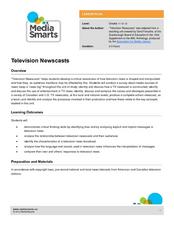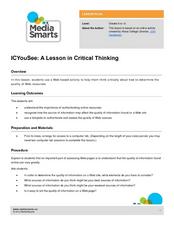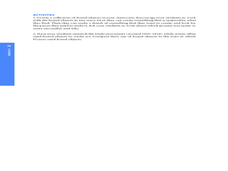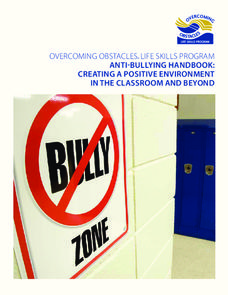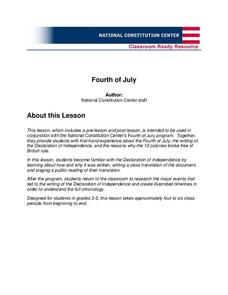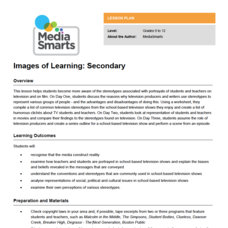Discovery Education
Our Brain and Body on Opioids
Use a presentation that explores the world of prescription opioids. Learners look at the way the brain responds to the drugs and the long terms effects opioids have on the brain and body. At the end of the lesson, groups create a social...
Curated OER
Television Newscasts
When we watch news broadcasts on television, we receive a much more visual perspective than when we read the newspaper. How do sets, clothing, and music contribute to our understanding of the story? Compare American and Canadian news...
Curated OER
Individuality vs. Conformity
Spark an animated debate in your class! Young adults consider some of the fads or trends that are prevalent at their school, as well as their own level of participation in them. Just how much of a role does popular culture play in their...
Curated OER
ICYouSee: A Lesson in Critical Thinking
Stress the importance of authenticating online resources and understanding the sources of websites' information with this activity. Using a Web-based activity, the lesson prompts young learners to think critically about determining the...
Curated OER
Innovations in Media
Learners analyze Pablo Picasso's art. In this Picasso art analysis lesson, students define collage and analyze Picasso's work in different mediums. Learners complete image based discussion activities. Students use found objects to create...
Overcoming Obstacles
Anti-Bullying Handbook: Creating a Positive Environment in the Classroom and Beyond
A hot-button topic in schools today is bullying, and although there is heightened awareness of this problem, information about specific steps schools can take to combat the problem and create a positive environment is difficult to find....
iCivics
Lesson 2: Misinformation
Fake news is a hot topic right now ... but what is it? Intrepid young investigators track down the facts that separate journalistic mistakes and misinformation through reading, research, and discussion. Part three in a five-lesson series...
iCivics
Lesson 3: Bias
How do journalists balance bias and ethical reporting? The final instructional activity in a series of five from iCivics examines the different types of bias and how they affect the news we read. Young reporters take to the Internet to...
Newseum
Political Persuasion: It’s All About Image
Political candidates work hard at creating an image they believe will appeal to voters. High schoolers collect 10 photos and other images of a candidate and analyze them to determine what techniques create a positive or negative impression.
Google
Online Safety Roadshow Activity
What does it mean to have digital citizenship? A set of lessons teach middle schoolers how to be safe and productive online. From sharing posts to creating secure passwords, learners discuss the importance of remaining diligent—and...
Curated OER
Hate 2.0
Combat hate online by bringing it into the light. Begin by giving learners a quiz, then lead a discussion based on the issues the quiz brought up. As a class, develop strategies to confront online hate. Assign different venues to groups...
Curated OER
Sports Personalities in Advertising
During a series of four activities, class members examine and deconstruct advertising that features famous athletes. They determine target audiences, analyze ads, explore "emotional climate," and role play a meeting between a sports...
Curated OER
Haring Inspired CD Covers
Students create CD covers from their music-inspired drawing sessions. They compare what they drew while listening to classical, punk and rap music. They scan their drawings into Adobe Photoshop and design their cover.
Department of Education (Ireland)
Understanding Influences
"Understanding Influences," a richly detailed, carefully scaffolded unit, asks middle and high school scholars to examine how internal and external factors like friends, media, and society influence their attitudes and...
National Constitution Center
Fourth of July (Grades 3-5)
Bring history to life for your young scholars with a Fourth of July lesson series. After a class reading of the Declaration of Independence, students translate this pivotal document into layman's terms before working in small...
Equality and Human Rights Commission
Influencing Attitudes
Does propaganda—like that used during the first World War—exist today? The 11th lesson in a series of 12 highlights the role of media when it comes to influencing attitudes. Scholars learn about sensational headlines, misrepresentation...
Media Smarts
Images of Learning: Secondary
Make your scholars more aware of stereotypical portrayals in film and television. Discuss the definition of "stereotypes" and how they are used to present a story. High schoolers look at specific television shows and complete a chart...
Curated OER
Evernote
Here is an app version of a powerful tool that allows you and your students to have one place where you can capture, organize, and share items in multiple media formats. The different uses for this app are as varied as your ideas...
Curated OER
Finding Content/Media
Sixth graders use the web to find and download photos, images, and clip art to create a large library of images in a short time. They survey audio and video files and other media by using various search engines. Remember to follow...
Newseum
Can I Trust the Creators?
It's easy to find information at the click of a mouse, but is it trustworthy? Pupils learn about the E.S.C.A.P.E. acronym for evaluating sources. Next, learners read a news story and evaluate its sources to determine credibility. Last,...
Curated OER
Political Cartoons: Literacy
Readers decode and deconstruct political cartoons to heighten critical thinking, extra-textual literacy, and making meaning from symbolism and metaphor. A compatible activity to use in English class when your 8th or 11th graders are...
Curated OER
Create a Youth Consumer Magazine
To underscore the importance of being informed consumers, kids check out youth consumer magazines and websites and then create their own. Although no detailed plans are included in the resource, it is packed with ideas and suggestions.
Curated OER
Wisdom of the Ages
Learners reflect on the different stages of life that humans pass through. They challenge common sense assumptions and critically engage media representations of people at different ages. They determine that media have embedded values...
Sharp School
The Bill of Rights and Supreme Court Cases Project
Social media and United States history combine as your young historians design a Facebook page for two major defendants of landmark Supreme Court cases. The resource includes a detailed rubric for research and page design, as well as a...

